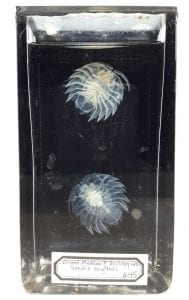Specimen of the Week 287: The Marine Isopods
By zcqsrti, on 14 April 2017
Research for this specimen on the week has been somewhat difficult, especially when a quick google search for it’s Latin name comes up with fruitful results of operation manuals for gasoline hedge trimmers, stamp catalogues for the enthused collectors of the Falkland Islands and an aged encyclopedia called the ‘Penny Cyclopaedia of The Society for the Diffusion of Useful Knowledge’ (a steal at only seven shillings and a sixpence).
~~The Marine Isopod, Serolis scythei~~
What we do know about these crustaceans is that they are Isopods, an order of animals that ranges in diversity from your cheery under-log-and-stone dwelling woodlice, to parasitic marine species that find their way into the mouth of fish before devouring and later replacing its tongue. There are about 10,000 known species of isopod: 4500 live in marine habitats (mostly found on the sea floor), while 500 species are freshwater. The remaining 5000 terrestrial species represent the most successful crustacean group ever to walk on land.

Serolis scythei, featuring both its shield like appearance, and scythe resembling thoracic segments. LDUCZ-H145
-The middle bits, bottom bits and pointy ends
The isopod body is divided into three main regions, the cephalon, thorax and pleon. Within the thorax itself there are seven segments, and each are associated with a pair of legs (or pereopods). The cephalon, or head, is fused to the first segment of the thorax. The pleon, or abdomen, is normally made up of five segments, each with a specialised organ called a pleopod used simultaneously for locomotion and respiration. In the case of Serolis scythei, a member of the family Serolidae, the pleon is short, giving them a more rounded shield-like appearance. The species gets its name from the tips of the thorax segments that resemble scythes; other species of seriolids share similarities, such as Acanthoserolis scythei, whom much to the excitement of the aforementioned stamp collectors, appears in a series of sea life stamps issued in 2013. Grand.
Relatively little is known about this family of isopods, let alone the genus Serolis, and new species are still being discovered. Individuals are able to use pigment cells called chromatophores to undergo colour and pattern changes, allowing for cryptic camouflage. If that isn’t enough to blend in with the surrounding environment, they can bury themselves just below the surface of the sea floor by wiggling their legs and descending into the substrate. Much to my own surprise, I did manage to find a video depicting a member of the Serolis genus being voyeuristically followed, and generally bothered by someone with a camera to unfitting music. Perhaps they are trying to sell it something, but as every isopod confidently knows, they’ve already got all that life can gift them.
-Serolis and the Silt Striders
I absolutely love crustaceans, and I think it stems from a love of fantasy. Perhaps it’s their almost spaceship-like aerodynamic structure, but there is something so alien and mysterious about their body shape that gives off a hint of serenity. In Bethesda’s fantasy role playing game Morrowind (2002), the native Dunmer of the Morrowind province symbiotically use giant crustacean-like arthropods called silt striders as a form of travel, shelter and protection (talk about amazing sound design, too! – the unmistakable call of a silt strider is heavily steeped in nostalgia for me). The serially overlapping bodyplan of Serolis scythei reminds me somewhat of the carapace of a silt strider, and I like to imagine they’re the juvenile of an- as of yet- undiscovered giant arthropodic beast that will later shape the course of human society, culture and housing.
Rowan Tinker is the Museum Intern at the Grant Museum of Zoology, UCL.
 Close
Close


